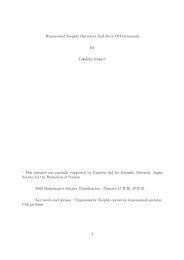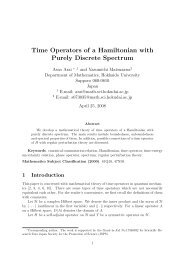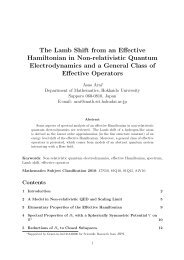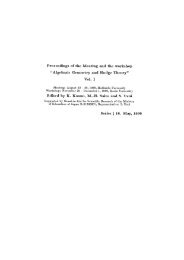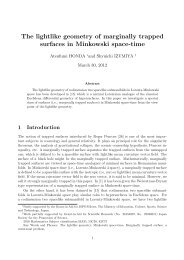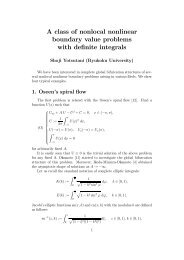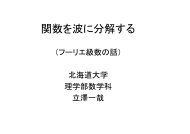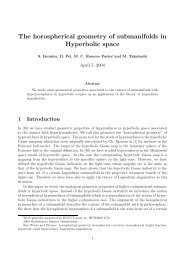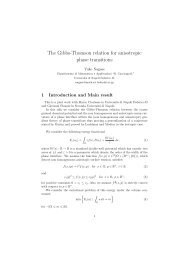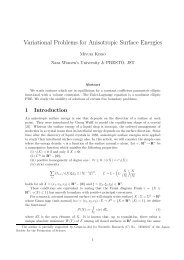Contact Geometry of second order I - Dept. Math, Hokkaido Univ ...
Contact Geometry of second order I - Dept. Math, Hokkaido Univ ...
Contact Geometry of second order I - Dept. Math, Hokkaido Univ ...
Create successful ePaper yourself
Turn your PDF publications into a flip-book with our unique Google optimized e-Paper software.
When f = f 1 (r) (see [Y4] §2), there exists a canonical coordinate system (xi, z, pi, pij)<br />
(1 ≦ i ≦ j ≦ n) <strong>of</strong> L(J) such that<br />
R = { ∂2z ∂xi∂xα<br />
(2) f2 (r) ⊂ S2 (V ∗ ) (r ≧ 2)<br />
= 0 (1 ≦ i ≦ r, r + 1 ≦ α ≦ n)}.<br />
(f 2 (r)) ⊥ = 〈{ei ⊚ ej | 1 ≦ i ≦ j ≦ r}〉 = S 2 (Vr),<br />
When f = f 2 (r) (see [Y4] §3), there exists a canonical coordinate system (xi, z, pi, pij)<br />
(1 ≦ i ≦ j ≦ n) <strong>of</strong> L(J) such that<br />
R = { ∂2 z<br />
∂xi∂xj<br />
(3) f 3 (r) ⊂ S 2 (V ∗ ) (r ≦ n − 2)<br />
= 0 (1 ≦ i ≦ j ≦ r)}.<br />
(f 3 (r)) ⊥ = 〈{ei ⊚ ea | 1 ≦ i ≦ r, 1 ≦ a ≦ n}〉 = Vr ⊗S V,<br />
When f = f 3 (r) (see [Y4] §4), there exists a canonical coordinate system (xi, z, pi, pij)<br />
(1 ≦ i ≦ j ≦ n) <strong>of</strong> L(J) such that<br />
R = { ∂2z = 0 (1 ≦ i ≦ r, 1 ≦ a ≦ n)}.<br />
∂xi∂xa<br />
Here {e1, . . . , en} is a basis <strong>of</strong> V , Vr = 〈{e1, . . . , er}〉 and Vs = 〈{er+1, . . . , en}〉 .<br />
We need Reduction Theorems to explain why <strong>second</strong> <strong>order</strong> equations with these symbols<br />
have the property that their symbols are the only invariants under contact transformations.<br />
We will explain this fact for the type f3 (r) in §6.1 by utilizing the First Reduction<br />
Theorem in §4. The other cases will be explained by utilizing the two step reduction<br />
procedure in Part II.<br />
4. P D manifolds <strong>of</strong> Second Order.<br />
We will here formulate the submanifold theory for (L(J), E) as the geometry <strong>of</strong> P D<br />
manifolds <strong>of</strong> <strong>second</strong> <strong>order</strong> ([Y1]) and discuss the First Reduction Theorem.<br />
4.1. Realization Theorem. Let R be a submanifold <strong>of</strong> L(J) satisfying the following<br />
condition:<br />
(R.0) p : R → J ; submersion,<br />
where p = π |R and π : L(J) → J is the projection. Let D 1 and D 2 be differential systems<br />
on R obtained by restricting C 1 = ∂E and C 2 = E to R. Moreover we denote by the same<br />
symbols those 1-forms obtained by restricting the defining 1-forms {ϖ, ϖ1, · · · , ϖn} <strong>of</strong> the<br />
canonical system E to R. Then it follows from (R.0) that these 1-forms are independent<br />
at each point on R and that<br />
D 1 = {ϖ = 0}, D 2 = {ϖ = ϖ1 = · · · = ϖn = 0}.<br />
In fact (R; D 1 , D 2 ) further satisfies the following conditions:<br />
(R.1) D 1 and D 2 are differential systems <strong>of</strong> codimension 1 and n + 1 respectively.<br />
(R.2) ∂D 2 ⊂ D 1 .<br />
(R.3) Ch (D 1 ) is a subbundle <strong>of</strong> D 2 <strong>of</strong> codimension n.<br />
(R.4) Ch (D 1 )(v) ∩ Ch (D 2 )(v) = {0} at each v ∈ R.<br />
12



